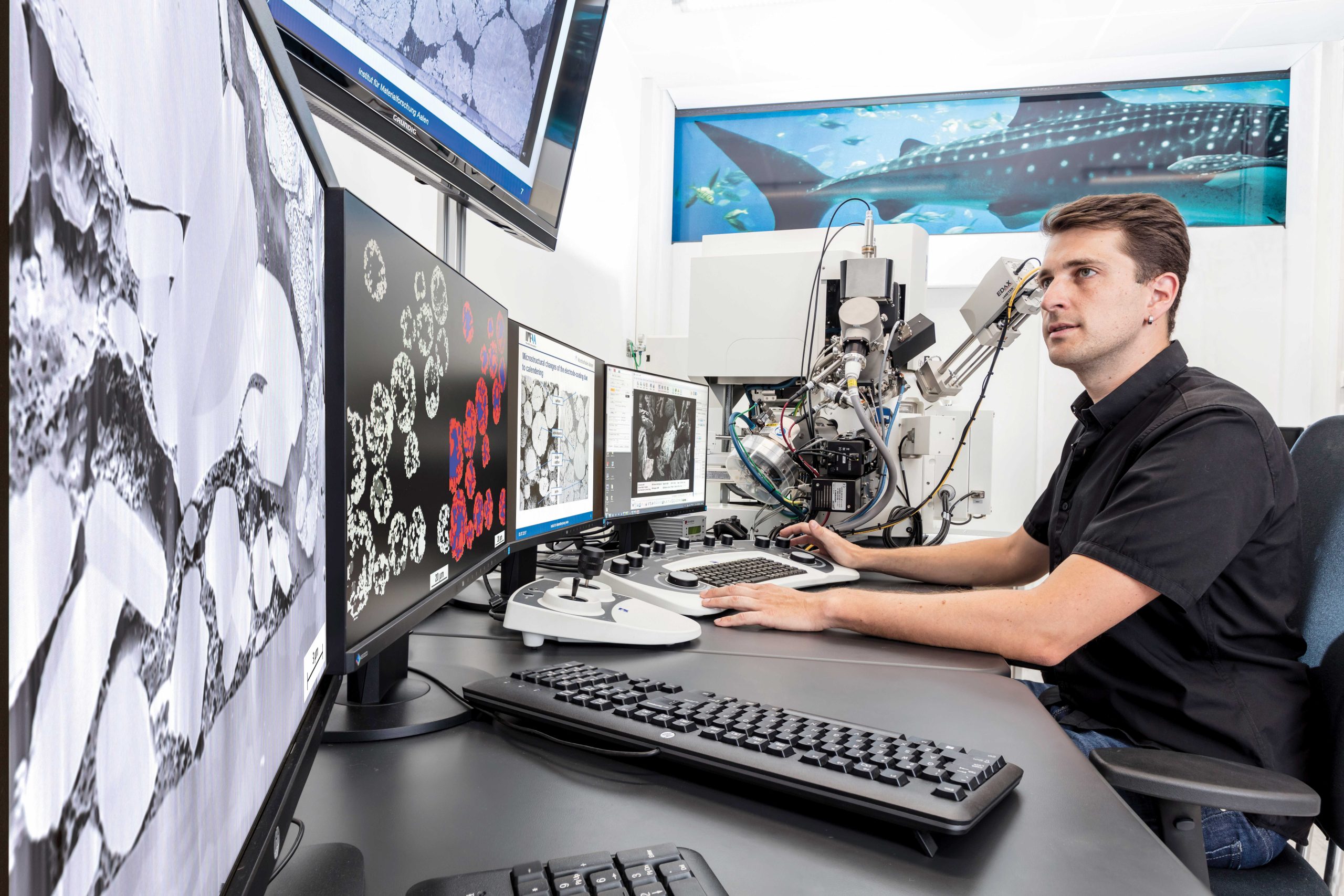 Hochschule Aalen für Bild der Wissenschaft Supplement 2017
Yannick Sieg im Labor für Elektromikroskopie mit Bildschirmen des Elektronenrastermikroskopes. Inhalt der Bildschirme v.l.n.r.: LCO-Kathode zeit eine Laserschnittkante, weiss-rote LFT-Partikel, Vergleich unverdichtete und verdichtete Kathodenbeschichtung,, ganz rechts Graphitpartikel für Batterien, Oben FIB-Tomographie zeigt stark verdichtete Kathodenbeschichtung.
Hochschule Aalen für Bild der Wissenschaft Supplement 2017
Yannick Sieg im Labor für Elektromikroskopie mit Bildschirmen des Elektronenrastermikroskopes. Inhalt der Bildschirme v.l.n.r.: LCO-Kathode zeit eine Laserschnittkante, weiss-rote LFT-Partikel, Vergleich unverdichtete und verdichtete Kathodenbeschichtung,, ganz rechts Graphitpartikel für Batterien, Oben FIB-Tomographie zeigt stark verdichtete Kathodenbeschichtung.
Research and innovation in the field of battery manufacturing mean at the same time more sustainable mobility and energy, more jobs and thus improved competitiveness for Europe. Researchers at Aalen University are now part of a Germany-wide project that aims to optimize the process steps involved in manufacturing a battery cell. To do so, the researchers are relying on state-of-the-art 3D analysis methods and machine learning.
Lithium-ion batteries are being used in more and more products – whether in cell phones, power tools, electric vehicles or large stationary energy storage systems. The increasing demand requires leaner and more efficient production techniques in battery cell manufacturing. “The manufacturing processes currently involve strong, cross-process interactions that we don’t yet really understand,” explains Andreas Kopp, a doctoral student at the Institute for Materials Research (IMFAA) at Aalen University. These unknown interactions still represent a real obstacle for the German production location to be able to manufacture battery cells efficiently and economically in high volumes for the global market.
A team at Aalen University (HS) is therefore currently researching the process steps of cell stack formation together with a consortium of relevant players from science (Karlsruhe Institute of Technology Institute of Production Engineering (KIT), Technical University of Berlin, Institute of Machine Tools and Factory Management) and industry (Jonas & Redmann Automationstechnik GmbH, Carl Zeiss Industrielle Messtechnik GmbH, Custom Cells Itzehoe GmbH, BST GmbH, J. Schmalz GmbH and Siemens AG). Kopp explains, “Each Li-ion cell consists of a negative and a positive electrode. Between the electrodes are the ion-conducting electrolyte, which enables the necessary exchange of charge, and the separator, which ensures the electrical separation of the electrodes. The individual components can be thought of as thin foils that are stacked or wound to build a cell.”
As part of the freshly launched “ProMoBatt” project (process modeling to optimize battery cell production), it is precisely this process step of cell stack formation that is being analyzed and systematically optimized. “Among other things, we want to take a close look at how the stacks lie on top of each other, whether and how an offset occurs, for example,” explains Kopp. To do this, the researchers from Aalen use non-destructive microscopic methods to look inside the cells: First, 3D computed tomography images enable a high-resolution, spatial analysis of the stack quality, the microstructure and, for example, the electrode position. Then machine learning comes into play: “Artificial intelligence helps us evaluate the data and identify any previously unknown cause-effect relationships.”
By the end of the project, which will run until February 2026, the researchers want to have found innovative, technical solutions for the areas of material web guidance, gripping and handling technology, and quality assurance, and to have implemented them concretely in a plant setup. The project at HS Aalen is being supported with around 305,000 euros from the German Federal Ministry of Economics and Climate Protection. Dr. Timo Bernthaler and Prof. Dr. Gerhard Schneider from the IMFAA management team are responsible for the project. www.hs-aalen.de
Read this and other articles on electromobility and autonomous driving in the current issue of eMove360° magazine in german language. Download it here free of charge or order the print version in the shop.